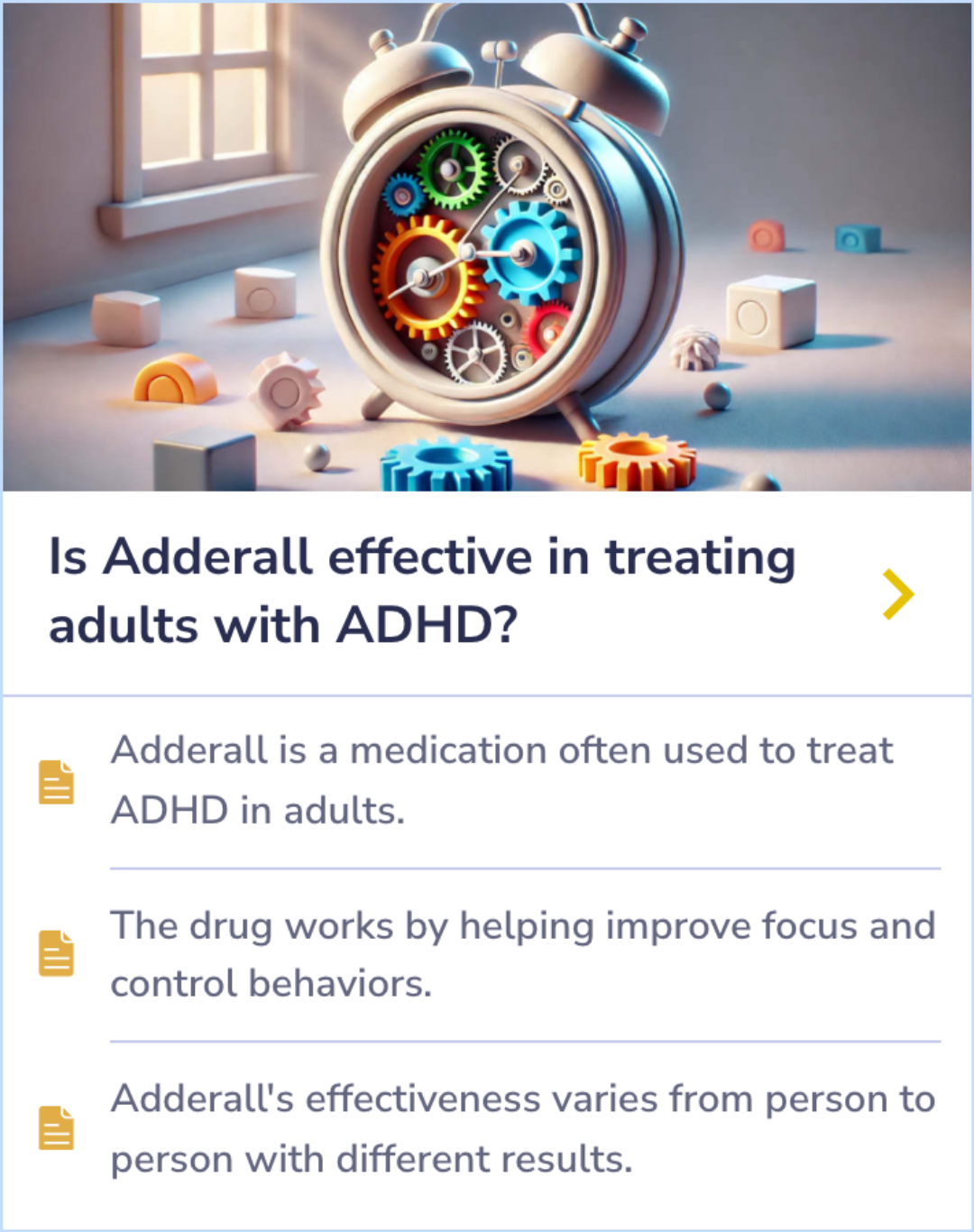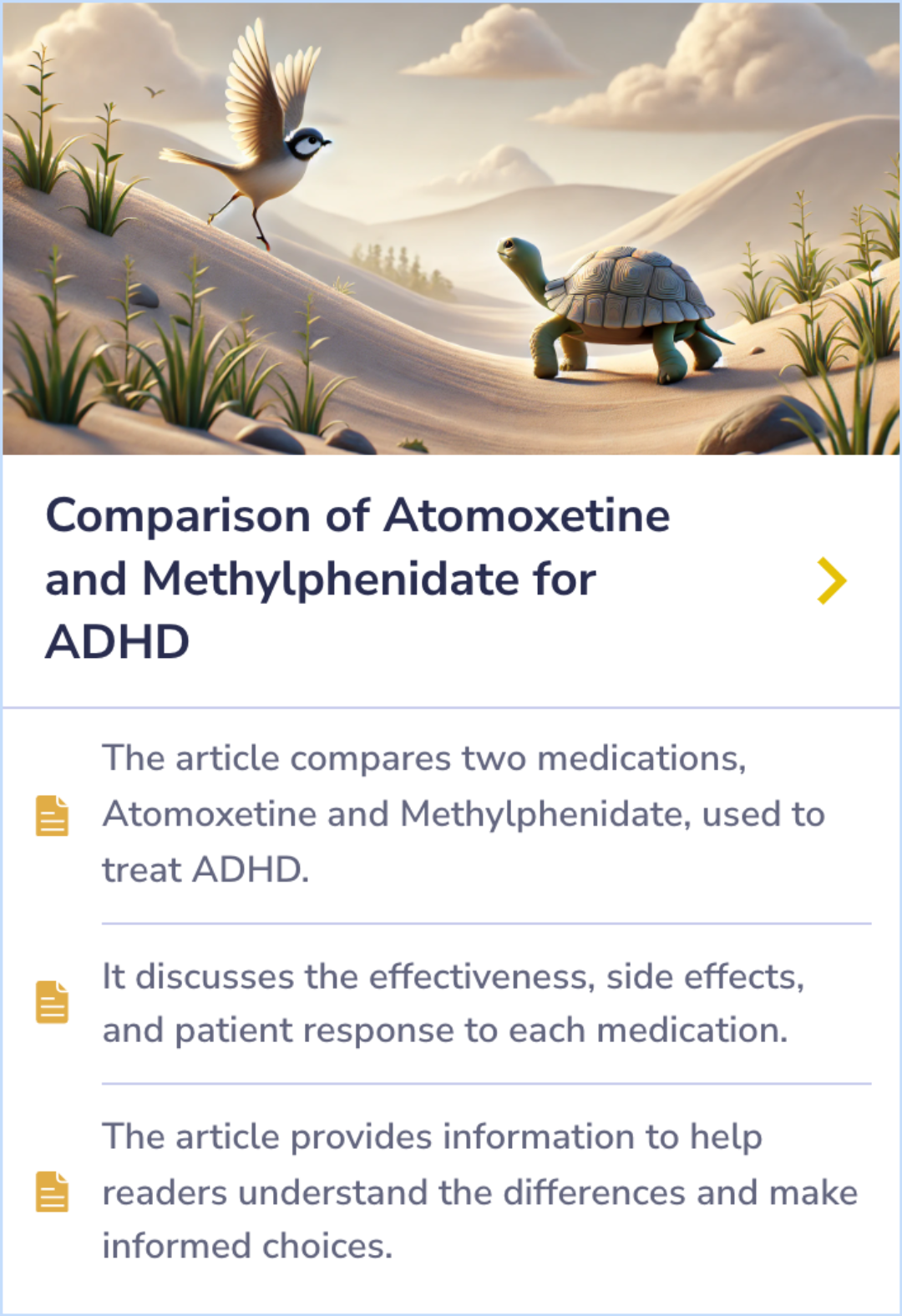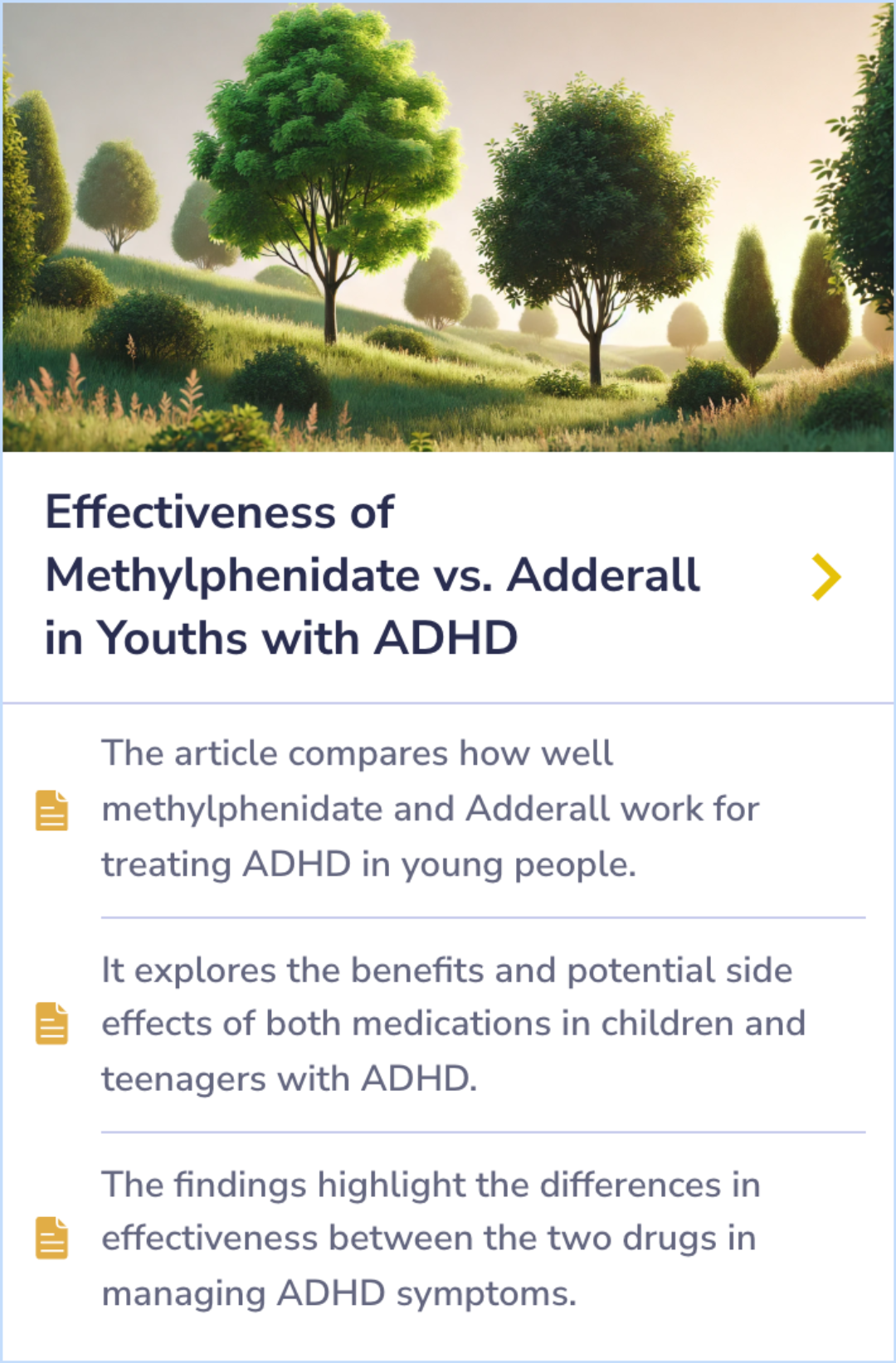Adderall
Evidence Based Answers
Adderall Indications
Adderall treats ADHD by improving focus and reducing impulsiveness. It is part of comprehensive plans, offering flexible dosing for children and adults, addressing various symptomatic needs.
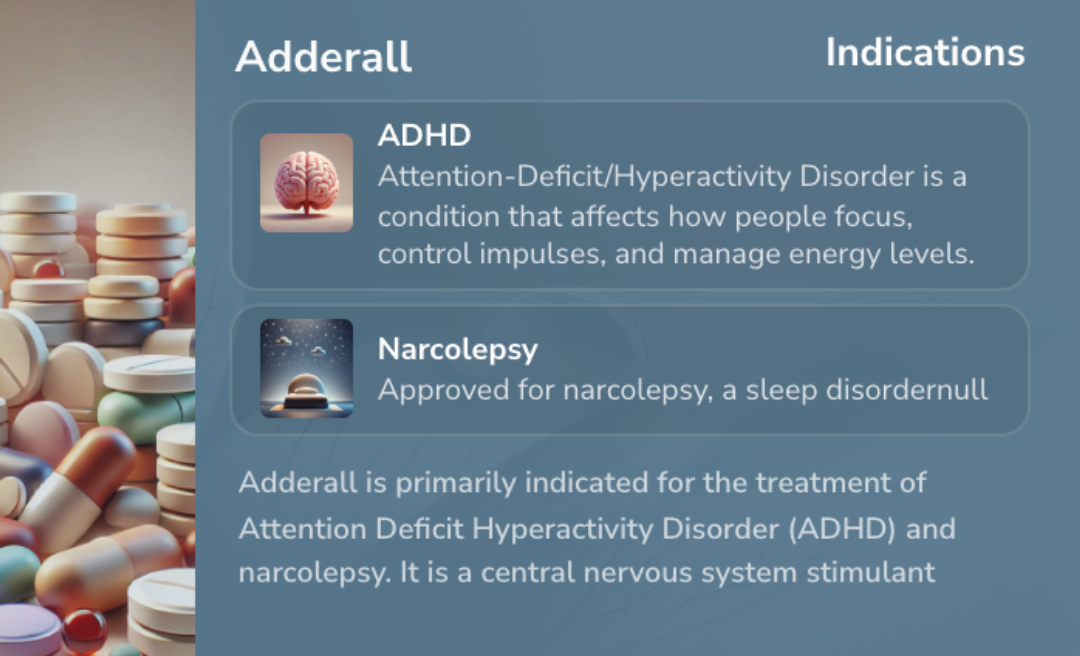
Adderall treats ADHD and narcolepsy, integrates in broader ADHD plans, and offers dosing for both children and adults.
Personal Experiences
Perspectives:
Primary Uses of Adderall
Adderall is primarily used to treat ADHD and narcolepsy. For ADHD, it can improve attention, reduce impulsivity, and manage hyperactive behavior. In narcolepsy, it helps control daytime sleepiness and sudden sleep attacks.
It is often included as part of a broader treatment plan, which may also involve therapy or behavioral support to address the wide range of ADHD symptoms.
It is often included as part of a broader treatment plan, which may also involve therapy or behavioral support to address the wide range of ADHD symptoms.
“
Source Quotes:
Adderall® is indicated for the treatment of Attention Deficit Hyperactivity Disorder (ADHD) and Narcolepsy.
The combination of dextroamphetamine and amphetamine (Adderall) is used as part of a treatment program to control symptoms of attention deficit hyperactivity disorder (ADHD; more difficulty focusing, controlling actions, and remaining still or quiet than other people who are the same age).
Adderall in ADHD Treatment Plans
Adderall is often part of a broader ADHD treatment plan, which can include counseling, special education, and other therapies. The specific approach is based on the patient's unique needs.
This comprehensive approach aims to address various aspects of ADHD symptoms.
This comprehensive approach aims to address various aspects of ADHD symptoms.
“
Source Quotes:
Adderall® is indicated as an integral part of a total treatment program for ADHD that may include other measures (psychological, educational, social) for patients with this syndrome.
You should know that dextroamphetamine and amphetamine should be used as part of a total treatment program for ADHD, which may include counseling and special education.
Adderall for ADHD in Children and Adults
Adderall is approved for treating ADHD in both children aged six and older and adults. It is commonly one of the first treatments prescribed.
Adderall is available in both immediate-release and extended-release formulations, providing flexible options for dosing.
Adderall is available in both immediate-release and extended-release formulations, providing flexible options for dosing.
“
Source Quotes:
Amphetamine is FDA-approved for the treatment of attention-deficit/hyperactivity disorder (ADHD) and narcolepsy. It has indications as a first-line agent for ADHD in adults and children six years of age and older.
The effectiveness of Adderall® for long-term use has not been systematically evaluated in controlled trials. Therefore, the physician who elects to use Adderall® for extended periods should periodically reevaluate the long-term usefulness of the drug for the individual patient.
How Adderall Works
Adderall works as a CNS stimulant, adjusting the levels of chemicals like dopamine and norepinephrine in the brain. This helps improve attention, control impulsiveness, and reduce hyperactivity in individuals with ADHD.
These effects explain why Adderall often leads to quick symptom relief, improving focus and behavioral control when used as directed.
These effects explain why Adderall often leads to quick symptom relief, improving focus and behavioral control when used as directed.
“
Source Quotes:
Amphetamine is a central nervous (CNS) system stimulant that functions by increasing the amounts of dopamine, norepinephrine, and serotonin (to a lesser extent) in the synaptic cleft through a variety of mechanisms.
The combination of dextroamphetamine and amphetamine is in a class of medications called central nervous system stimulants. It works by changing the amounts of certain natural substances in the brain.
Key Takeaways
Conclusions
Adderall is widely recognized for its role in treating ADHD and narcolepsy by enhancing attention, reducing impulsivity, and managing hyperactive behaviors. In ADHD, it forms part of a comprehensive treatment plan which includes therapies tailored to individual needs to address the spectrum of symptoms.
This medication, approved for both children and adults, is available in multiple formulations that adjust neurotransmitter levels to improve focus and behavior control, offering swift symptom relief as a central nervous system stimulant.
This medication, approved for both children and adults, is available in multiple formulations that adjust neurotransmitter levels to improve focus and behavior control, offering swift symptom relief as a central nervous system stimulant.
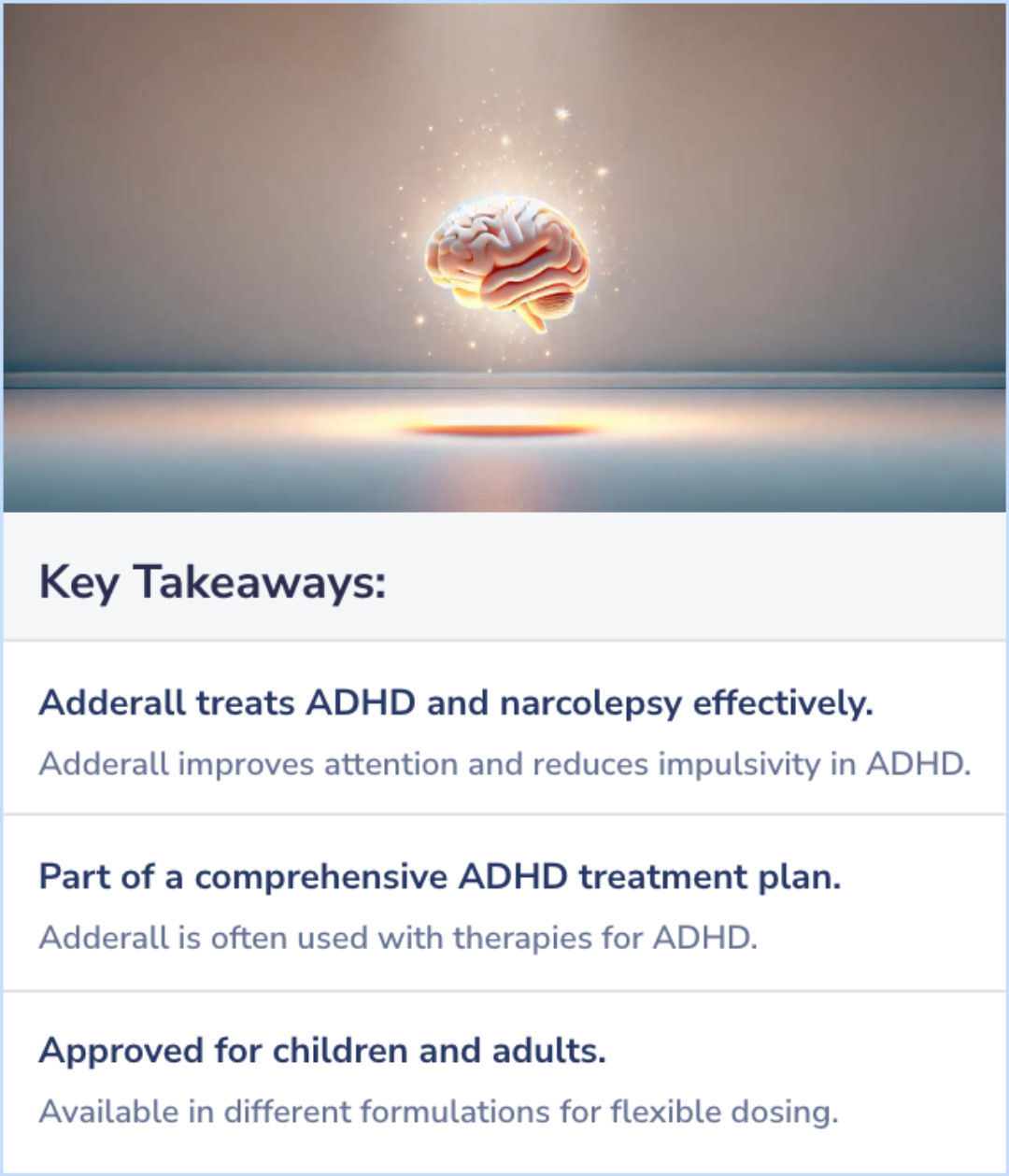
Evidence Summary
Adderall’s Role in Adult ADHD Treatment
Adderall is a common treatment for adults with ADHD, boosting focus and helping manage behaviors. However, its impact can vary; while some people see major improvements in concentration and self-control, others experience less pronounced changes. Adderall's effects are shaped by individual differences, making outcomes unpredictable.
The medication works by improving focus and reducing impulsivity through changes in brain chemicals, offering targeted symptom relief.
The medication works by improving focus and reducing impulsivity through changes in brain chemicals, offering targeted symptom relief.
Evidence Summary
Comparing ADHD Treatments: Atomoxetine vs. Methylphenidate
Atomoxetine and Methylphenidate, both used for ADHD, differ in their effectiveness, side effects, and how patients respond. While one may work faster for some, the other offers alternative benefits, depending on individual needs.
The comparison focuses on patient experiences and outcomes, highlighting which medication might suit different cases better based on tolerance, symptom relief, and side effect profiles.
This insight supports those navigating treatment options and responses.
The comparison focuses on patient experiences and outcomes, highlighting which medication might suit different cases better based on tolerance, symptom relief, and side effect profiles.
This insight supports those navigating treatment options and responses.
Evidence Summary
Methylphenidate vs. Adderall: ADHD Treatment Comparison
Comparing two widely used ADHD medications, this article sheds light on the differences between methylphenidate and Adderall in treating young people. It examines how each drug manages ADHD symptoms in children and teens, revealing unique aspects of their effectiveness.
The study highlights the benefits and potential side effects associated with each medication, helping distinguish which might suit different patients and treatment goals.
By analyzing both drugs, the study provides a clearer picture of their roles in ADHD management for youth.
The study highlights the benefits and potential side effects associated with each medication, helping distinguish which might suit different patients and treatment goals.
By analyzing both drugs, the study provides a clearer picture of their roles in ADHD management for youth.
